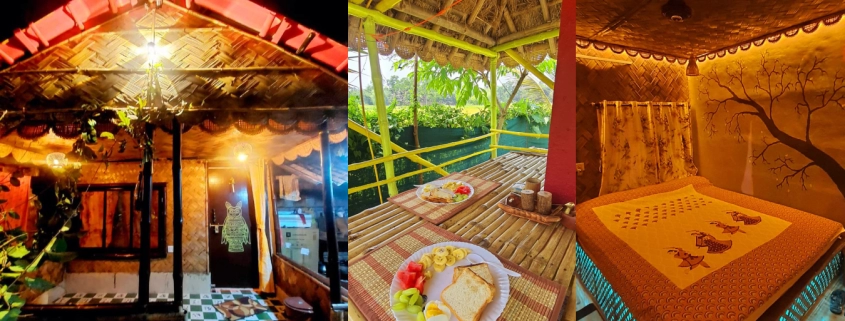Ramnagar Village Sikkim: Ultimate Guide
Ramnagar village is located in the East Sikkim district of the northeastern Indian state of Sikkim. It is situated close to the Teesta River and is around 31 kilometers away from the capital city of Gangtok.
How to reach Ramnagar village?
By Air
The closest airport to Ramnagar village is Pakyong Airport in Gangtok which is around 35 km away. This is a small domestic airport with flights from major Indian cities like Delhi, Kolkata, and Guwahati. You can easily get taxis from the airport to Ramnagar which takes around 1.5 hours. Make sure to book the taxis in advance.
By Rail
The nearest railway station is the New Jalpaiguri Railway Station in Siliguri, West Bengal. It is about 125 km away from Ramnagar village. From here you can hire a taxi or board a bus to reach Ramnagar. The journey typically takes 4-5 hours depending on the traffic. Some of the bus routes you can consider are Siliguri to Gangtok or Siliguri to Rangpo.
By Road
Ramnagar is well connected with other parts of Sikkim and West Bengal via road. Here are the routes you can take:
- From Gangtok – Hire a private taxi or board a state bus. The distance is about 35 km and it takes around 1.5 hours.
- From Siliguri- Take a taxi or bus to reach Gangtok first and then travel to Ramnagar as mentioned above. Total distance is 130 km and the journey roughly takes 4-5 hours.
- From Rangpo- Shared taxis are available from Rangpo to Ramnagar. It is a distance of 17 km and takes about 40 minutes.
Make sure you start your journey early in the morning as roads in hilly areas are prone to blocks and delays due to fog, rainfall or other issues. Carry motion sickness medicines if you feel uneasy while travelling on winding hill roads.
History of Ramnagar Village
Ramnagar village has an intriguing history. As per local legends and village elders, Ramnagar was established by five pioneer families – Rai, Chettri, Subba, Pradhan and Limbu families – nearly 200 years ago. They found the place suitable for settlement and cultivation. Initially named Phagidhara after the medicinal herb found in abundance here, the place got renamed as Ramnagar in early 1900s.
Some notable historical events and sites in Ramnagar village are:
Phagidhara Monastery: Built in 1850s, this old Buddhist monastery stands testimony to the village’s antiquity. Tourists still visit it to see the intricate wall paintings and architecture.
Teesta River: This iconic river has shaped the geography of the region since time immemorial. Ramnagar’s early settlers set up farms on the fertile plains watered by Teesta and it continues to impact agriculture and lifestyle here.
Zuluk Trekking Trail: The ancient silk route connecting India and Tibet via Jelep La pass used to run close to present-day Ramnagar village. Zuluk valley was an important pitstop on this trade route. Trekkers can still trace parts of it while hiking.
British Bungalows: A few dilapidated British-era bungalows can still be found in Ramnagar. These served as residences of British officers posted in the hills during the colonial rule. The distinct English architecture of these ruins stands in stark contrast to traditional Sikkimese homestays in the village.
So if you visit Ramnagar village, make sure to spend some time at these heritage sites to appreciate its rich history. Interact with the friendly locals to discover more interesting trivia!
What is Ramnagar Village Famous For?
Ramnagar village and its surrounding areas have gained renown for their incredible natural beauty, unique travel experiences and diverse culture.
Scenic Landscapes
Blessed with gentle rolling hills, verdant valleys, sparkling rivers and magnificent mountain peaks like Kanchenjunga, Ramnagar offers breathtakingly beautiful vistas. The dreamy landscapes surrounding the village look like paintings come alive! Popular viewpoints like Chenrezig Statue and Ganesh Tok will make your jaw drop with their otherworldly charm.
Teesta River Activities
The currents of the gorgeous Teesta river allow for some exciting water sports near Ramnagar village. Visitors flock here to enjoy white water rafting, kayaking, angling and boating in Grade 2-4 rapids against a scenic mountain backdrop. Yak rides and hiking trails along the riverbanks are other ways to soak in the scenery.
Tribal Culture Experiences
Get a peek into the vibrant culture of Sikkim’s local tribes in and around Ramnagar village. Interact with Lepchas, Bhutias and Nepalis, visit monasteries, try authentic cuisine, see traditional dances and music, shop for exquisite handicrafts etc. Don’t miss out on festivals like Losoong, Sakewa and more.
Zuluk Valley
Just 17 kms from Ramnagar across zig-zag roads lies the breathtaking Zuluk Valley perched at 10,000 feet. Visit during winter to play with snow and enjoy sunrises over snow clad Himalayas. Nag Temple, Phedang railway shed, Eagle’s Nest bunker and scenic viewpoints are top attractions.
So whether you love nature, adventure or culture, Ramnagar promises an incredible holiday amidst the Himalayas far from the tourist crowds!
Local Cuisine of Ramnagar Village
The eclectic local cuisine of Ramnagar village reflects diverse ethnic influences. As a frontier region, it absorbed culinary influences from neighboring Nepal, Tibet as well as different Sikkimese communities over centuries. Rice is the staple food here while other common ingredients include ferns, bamboo shoots, meat, dairy products etc. Here’s a glossary of must-try local delicacies in Ramnagar.
1. Momos: These piping hot Tibetan style dumplings stuffed with vegetables or meat need no separate introduction! Savor them with chili sauce to warm yourself in cold weather.
2. Thukpa: This thick boneless chicken/mutton soup with noodles, veggies and herbs is the ultimate comfort food after a long day of sightseeing.
3. Gundruk Soup: This tangy, fermented vegetable soup tastes like a powerhouse of health benefits. Don’t miss this immunity booster!
4. Sael Roti: Fried bread made of wheat/millet flour cooked in mustard oil is a Nepali specialty found everywhere in Ramnagar. Great with tea or curries.
5. Chhurpi: Hard cheese made by boiling buttermilk is quite a unique tasting experience. It can be eaten raw or stir fried with veggies. An acquired taste but worth trying!
6. Bamboo Shoot Curries: Bamboo shoots are harvested from local forests and made into mouthwatering curries along with peas, greens, spices etc. A stellar regional delicacy!
7. Sinki Soup: Another delightful soup made with radish taproot, green leaves, beaten rice and chillies. Best for warding off tiredness and body aches.
8. Gya Thuk: A mix of glass noodles, lamb/chicken, loads of veggies and spices. This one-pot meal is warming, healthy and easy to digest. Popular comfort food here.
So on your Ramnagar holiday, save room in your appetite to feast on these delectable local dishes along with standard Indian-Chinese offerings found in restaurants here!
Stay Options in Ramnagar Village
Ramnagar village offers a good variety of comfortable and affordable stay options to cater to different budgets and needs.
Homestays
For an authentic cultural experience, homestays in Ramnagar village are your best bet. Staying with warm local families lets you observe and participate in daily village life. Expect basic facilities but rich cultural immersion.
Hotels
There are a handful of hotels in Ramnagar that offer modern amenities like room service, restaurants etc. Most hotels can arrange local tours as well. Mid-range charges but good comfort.
Eco Cottages & Camps
Several eco-resorts have opened along the banks of the Teesta River just outside Ramnagar village. Cottages/camps/tents with outdoor bonfires and rural backdrop for adventurous souls.
Monastery Guesthouses
Many Buddhist monasteries around Ramnagar village like Phodong, Phen Sang and Tsongo have guesthouse facilities for tourists. Stay here for a minimalist and quiet vacation while soaking in spirituality. Opportunity to interact with monks.
Best Time To Visit Ramnagar Village
Ramnagar village enjoys pleasant weather throughout the year barring monsoons. However the ideal time for your visit depends on what you want to experience here:
Spring (March – May): Moderate temperatures, clear skies and blooming rhododendrons make spring perfect for treks, village tours and exploring culture. Can observe ethnic festivals too. Avoid early March due to Holi festival crowd.
Summer (June – August): Warm, sunny days but risk of sudden monsoon showers by July-end. Good for rafting, kayaking etc but avoid long treks. Pleasant weather in evenings and mornings for village walks.
Autumn (September – November): Post monsoon time has crystal clear skies, lush greenery and river rapids at their best flow. Moderate day temperatures encourage outdoor sightseeing. Perfect time for trekking as well before winter chill sets in.
Winter (December – February): Subzero temperatures coupled with snowfall transforms Ramnagar village into a winter wonderland! Time for snow games in Zuluk valley. Tourist numbers increase so book in advance. Carry plenty of warm clothes. Daytime pleasant but extremely cold nights.
Monsoons (July – August): Avoid visiting Ramnagar if possible as landslides and road blocks are common. Cloudy skies mar scenic views while persistent rainfall hampers outdoor sightseeing. River rafting reaches peak danger levels. Low tourist season anyway.
So decide when you want to visit Ramnagar village based on the experiences or activities you are keen on and schedule your trip accordingly.
Budget for a Ramnagar Trip
Here’s a ready reckoner for how much a holiday in Ramnagar village will cost based on travel style:
Backpacker/Solo Budget Trip
- Accommodation+Food: INR 600-1000 per day if staying in homestays or monastery guesthouses and eating simple village meals
- Local Transport: INR 300-500 per day for shared taxis, bus fares
- Sightseeing+Activities: INR 500-800 per day (entry tickets, short treks etc)
Total: Around INR 1500-2500 per day
Mid-range Trip for Couple
- Accommodation+Food: INR 2000-4000 per night for hotels inclusive of restaurants
- Local Transport: INR 800-1000 per day for reserved taxis
- Sightseeing+Activities: INR 1000-1500 per day (guides, equipment rentals, medium treks etc)
Total: Around INR 5000-7000 per day
Luxury Family Trip
- Accommodation: INR 6000-10,000+ night for premium eco resorts
- Food+Drinks: INR 3000-5000 per day
- Transport: INR 2000+ per day for AC Innova taxis
- Sightseeing: INR 2000+ for activities like rafting, yak rides etc
Total: INR 15,000+ per day
Additional costs to account for – souvenir shopping, tour guide fees, winter clothing rentals, insurance, photography charges, packed food and water etc.
So budget accordingly for your Ramnagar holiday based on your travel style and duration of stay!
Conclusion
In conclusion, Ramnagar village is an offbeat gem that makes for a rejuvenating holiday amidst breathtaking Himalayan scenery. This comprehensive guide has all the information you need to plan your visit – from reaching Ramnagar and its intriguing history to what’s in store for you like stunning landscapes, adventurous water sports along River Teesta, a vibrant local tribal culture waiting to be discovered, soul-warming cuisine, comfortable accommodation as well as tips on best time to visit and expected trip budgets.
With these insights, booking your tickets to Ramnagar right away seems like a great idea! Just don’t forget to keep your camera batteries charged to capture the postcard-perfect frames you will encounter everywhere during your holiday in one of Sikkim’s hidden secrets. Have a great time!


Leave a Reply
Want to join the discussion?Feel free to contribute!